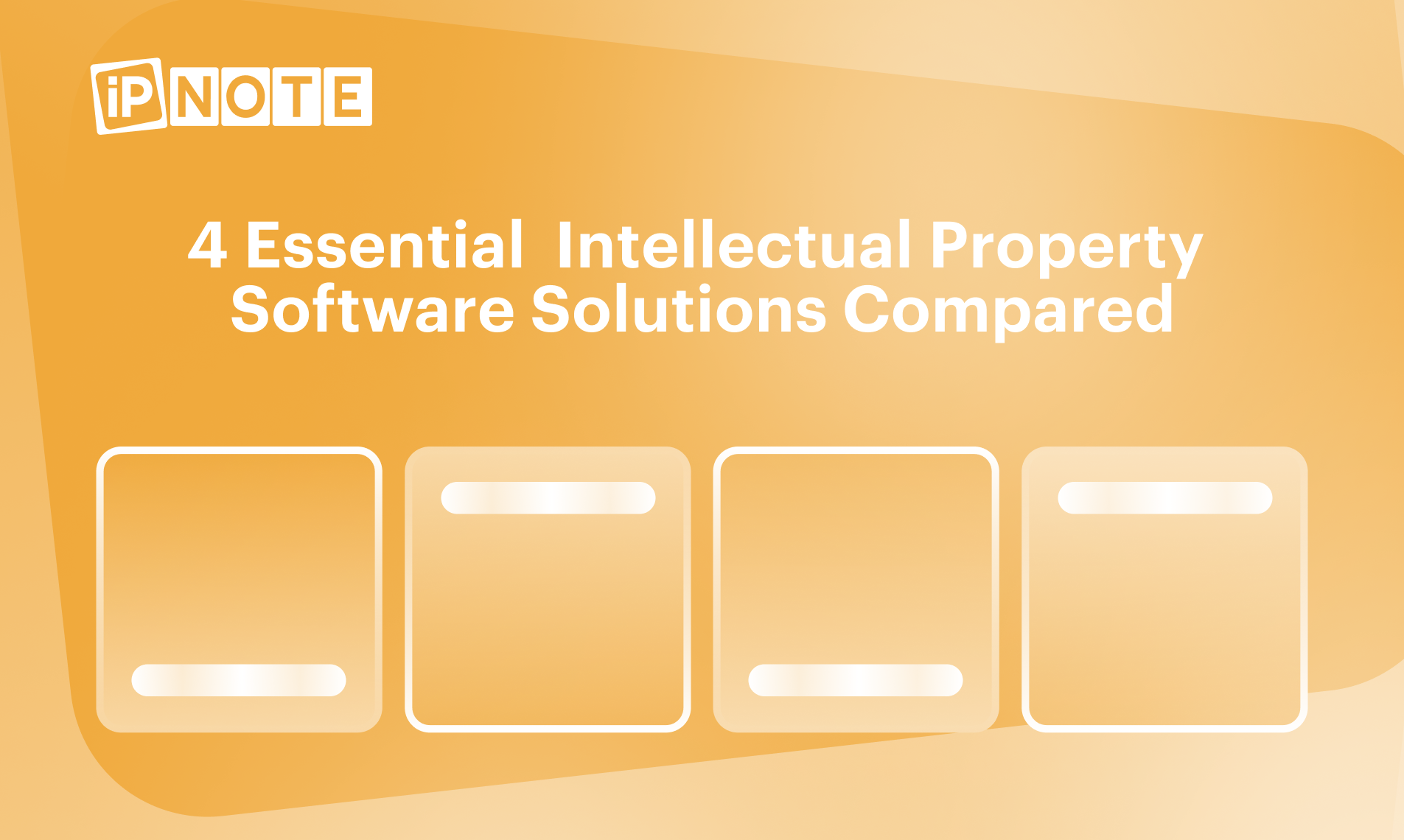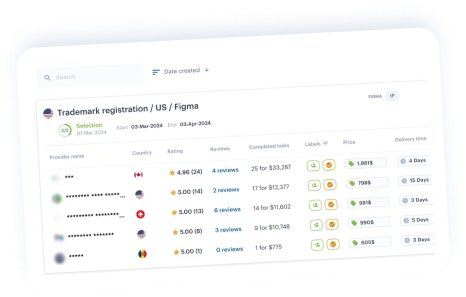Overview
This article provides a comprehensive comparison of four essential intellectual property (IP) software solutions, evaluating their features, advantages, and disadvantages. By doing so, it aids organizations in selecting the appropriate tool for managing their IP assets.
Each solution—iPNOTE, AppColl, Alt Legal, and Inteum—boasts unique strengths and weaknesses. Organizations are encouraged to assess their specific needs, budget, and user experience when choosing an IP management software. This careful consideration not only enhances the management of IP assets but also ensures alignment with organizational goals.
Introduction
In the competitive landscape of modern business, effective management of intellectual property (IP) is not merely important; it is a critical component for success. Organizations are increasingly striving to protect their innovations, and in response, the rise of specialized IP management software presents a powerful solution.
These tools streamline the tracking and enforcement of patents, trademarks, and copyrights, while leveraging advanced technologies like artificial intelligence to enhance decision-making processes. Platforms such as iPNOTE are leading this charge, enabling companies to optimize their IP strategies, reduce operational costs, and ensure compliance with ever-evolving regulations.
As the demand for sophisticated IP management solutions continues to grow, it becomes essential for corporate IP managers to understand the features, benefits, and potential drawbacks of these systems in order to navigate this complex domain effectively.
Understanding Intellectual Property Management Software
Understanding Intellectual Property Management Software
Intellectual Property (IP) management software plays a pivotal role in helping organizations safeguard their intangible assets, including patents, trademarks, copyrights, and trade secrets. These advanced intellectual property software solutions streamline the tracking, registration, and enforcement of IP rights, allowing businesses to effectively protect their innovations. As digital transformation accelerates, there is a significant shift towards AI-driven solutions, which not only automate routine tasks but also provide valuable analytics and insights to enhance intellectual property software solutions. By 2025, the incorporation of AI in intellectual property software solutions is increasingly recognized for its capacity to improve workflows, reduce operational expenses, and ensure compliance with evolving IP regulations.
Key definitions are essential for understanding the platform:
- “User” refers to the individual or organization utilizing the service;
- “Account” is the collection of settings and information associated with a User;
- “Task” denotes a service request made by a Client to potential Consultants;
- “Consultant” refers to the professionals providing IP-related services.
iPNOTE’s platform exemplifies this trend by offering extensive features that reduce IP costs and grant access to a broad array of international providers. Users can automate task creation, set reminders, and gain quick access to their IP portfolio, which includes not only patents but also products and developments. The platform supports advanced task coordination, allowing corporate IP managers to set tasks, receive fixed-price offers from providers, and track progress seamlessly. All providers utilize the same tools, facilitating payments in various currencies directly through the chat interface, ensuring a streamlined experience.
The significance of intellectual property software solutions is underscored by the increasing adoption of cloud technologies, which enable the creation of cloud-based IP control systems. This trend is particularly crucial in the IT and Telecom industries, which dominate the market share for intellectual property software solutions, representing the largest segment during the projected period. Furthermore, industry leaders emphasize that AI’s role in intellectual property software solutions is transformative, empowering organizations to navigate the complexities of intellectual property with greater agility and precision.
Real-world examples illustrate the effectiveness of AI-powered IP control solutions. For instance, iPNOTE’s marketplace fosters collaboration between legal professionals and patent attorneys, providing a virtual community for expert advice and support. This strategic advantage is vital for businesses operating in the rapidly evolving landscape of intellectual property oversight. As corporate IP administrators increasingly recognize the key benefits of intellectual property software solutions, including enhanced efficiency and improved decision-making capabilities, the demand for such advanced systems continues to rise.
Moreover, the flexibility of IP oversight tools is highlighted by the ability to customize reports and agreements to meet client needs, demonstrating how these resources can be tailored to accommodate diverse organizational requirements. iPNOTE is also dedicated to data privacy and security, ensuring that all user information is safeguarded in accordance with relevant regulations. As the landscape of intellectual property oversight evolves, understanding both the advantages and potential drawbacks of AI-driven approaches will be essential for corporate IP administrators seeking to leverage technology effectively.
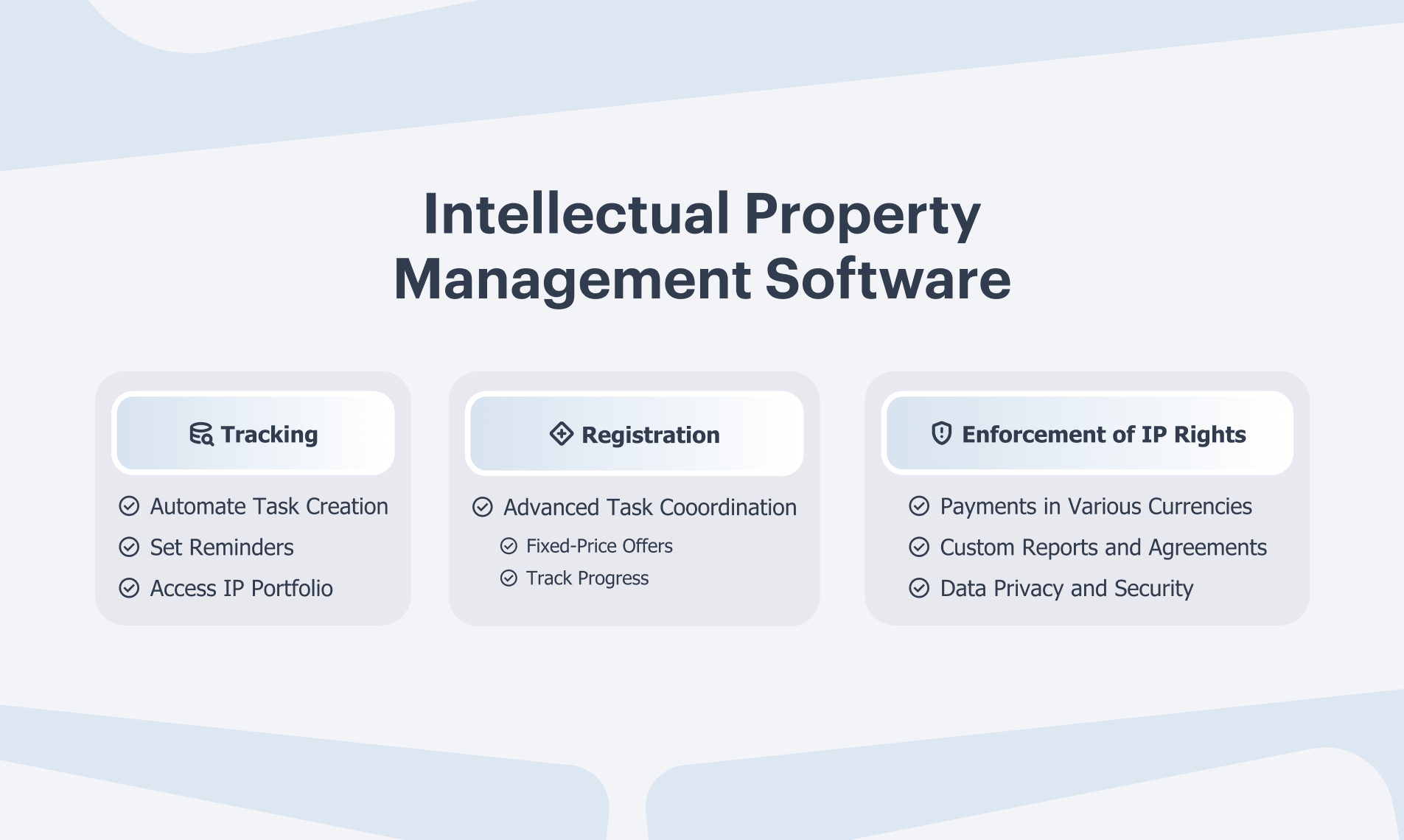
Key Features of Leading IP Management Solutions
Leading intellectual property software solutions in 2025 are characterized by essential features that significantly enhance efficiency and
effectiveness in managing intellectual property assets.
- Automated Tracking: A crucial feature for monitoring deadlines related to renewals and filings, automated tracking significantly reduces the risk of missed deadlines. Statistics reveal that this capability can improve compliance rates by over 30%. Our patent expert team serves more than 2,500 patent holders across 40+ countries, showcasing its effectiveness in diverse jurisdictions. The application enhances this with automation tools that streamline task creation and reminders, enabling users to efficiently manage their intellectual property software solutions while eliminating routine processes.
- Centralized Database: A single repository for all IP-related documents simplifies access and organization, ensuring that critical information is readily available. This centralization is vital for organizations managing diverse portfolios across multiple jurisdictions. The platform keeps your entire portfolio organized and secure, facilitating progress tracking and connections with various IP rights.
- Analytics and Reporting: Advanced analytics tools provide insights into IP portfolio performance, empowering organizations to make data-driven decisions. These capabilities support long-term financial planning and align IP assets with business goals. The AI-driven chat interface further streamlines reporting and risk management, enhancing the decision-making process.
- Collaboration and Support Tools: Effective communication among team members and external stakeholders is facilitated through integrated collaboration tools, enhancing workflow efficiency and project management. The platform enables seamless collaboration with internal and external providers, ensuring all stakeholders are aligned and informed. Additionally, it offers personalized contractor support and a global provider network, enhancing the user experience.
- Compliance Management: Robust compliance features in our intellectual property software solutions ensure adherence to legal requirements and industry standards, minimizing the risk of legal disputes. An effective IP governance system incorporates country law rules for hundreds of jurisdictions, as emphasized by industry experts from the Dennemeyer Group. These intellectual property software solutions facilitate compliance oversight through streamlined processes and task tracking.
- Integration Capabilities: Seamless integration with other business systems, such as CRM and ERP, allows for a holistic approach to IP oversight, streamlining processes and enhancing overall operational efficiency. The platform is designed to work with various systems, boosting its usability.
- Forecasting Capabilities: The platform’s forecasting features aid in long-term financial planning for intellectual property portfolios, making these intellectual property software solutions essential for corporate IP managers. Advanced task organization capabilities enable individuals to establish tasks and monitor progress efficiently.
Recent case studies, such as the strategic alliances formed by CPA Global with Anaqua and IPfolio, illustrate the trend toward integrated offerings that enhance the functionalities of IP software. These collaborations aim to provide comprehensive tools that address the complexities of contemporary IP oversight, making it crucial for corporate IP administrators to stay informed about the latest features and functionalities available in the market, including those provided by other platforms.
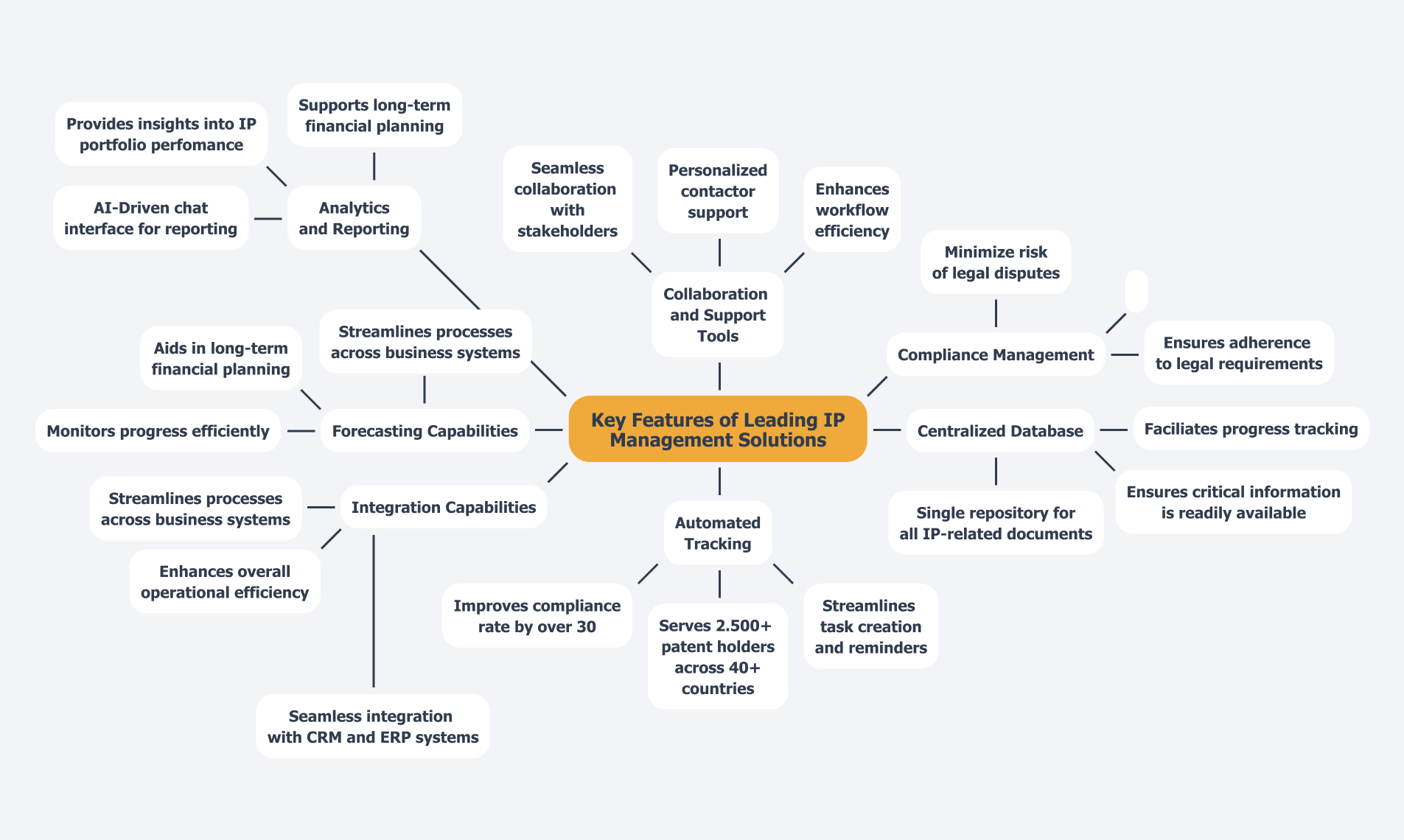
Evaluating Pros and Cons of Each Software Solution
When evaluating IP management software solutions, it is essential to weigh their respective advantages and disadvantages:
- iPNOTE:
- Pros: iPNOTE has proven to be a transformative platform for global intellectual property management. Case studies demonstrate a 7x return on investment in deal numbers and significant growth in client acquisition through effective advertising strategies. For instance, in the Asian market, the company developed a strategy that attracted $20,000 in a year. Clients commend the service for its streamlined process, enabling them to effortlessly connect with potential clients and effectively manage their intellectual property software solutions. Testimonials from pleased clients, including Wayne Carroll from Inspired Idea Solutions, emphasize the platform’s simplicity and dependability, asserting, “This service makes the process of hiring foreign associates easy.”
- Cons: While this application excels in many areas, some individuals may find the initial learning curve challenging as they adapt to its comprehensive features. Furthermore, as with any platform, there may be occasional technical issues that require prompt attention; however, individuals have noted that iPNOTE’s support team is attentive and responsive. Streamlining the learning process could improve the experience of using intellectual property software solutions further.
- AppColl:
- Pros: Known for its user-friendly interface, AppColl excels in fostering collaboration among teams and offers robust reporting tools that enhance visibility into IP management processes. It is also acknowledged as the most utilized docketing solution for members of the National Association of Patent Practitioners, highlighting its effectiveness and popularity among individuals.
- Cons: However, it offers restricted customization choices and tends to be more expensive than certain rivals, which may dissuade cost-sensitive individuals. A paralegal noted, “This docketing program simplifies my life…REALLY !!!” highlighting its practical benefits.
- Alt Legal:
- Pros: Alt Legal stands out for its exceptional trademark management capabilities, featuring automated filing processes that save time and reduce errors. Users also appreciate its strong customer support, which enhances the overall experience.
- Cons: On the downside, it may lack certain advanced analytics features found in other solutions, potentially restricting detailed data analysis for certain individuals. Furthermore, individuals have reported occasional bugs in the search function, which could impact usability.
- Inteum:
- Pros: Inteum offers comprehensive patent management capabilities and integrates seamlessly with research and development processes, making it a valuable tool for organizations focused on innovation.
- Cons: The software has a steeper learning curve for newcomers, and its implementation costs can be significant, which may pose challenges for smaller firms.
- Wellspring IP:
- Pros: With strong analytics and reporting features, Wellspring IP is particularly well-suited for large organizations managing extensive IP portfolios, providing insights that drive strategic decision-making.
- Cons: Its complexity in setup may require dedicated IT resources, which could be a barrier for smaller teams or those without technical support.
In 2025, satisfaction statistics suggest that Alt Legal continues to be a favored option among corporate IP managers, especially for its simplicity and efficient deadline notifications. However, specific data points regarding user satisfaction compared to other options would further enhance clarity. Meanwhile, iPNOTE remains acknowledged for its innovative approach and client-focused features, establishing it as a strong competitor in the IP software landscape. Each intellectual property software solution presents unique strengths and weaknesses, making it crucial for organizations to align their choice with specific operational needs and budget considerations.
Choosing the Right IP Management Software for Your Organization
Selecting the right IP management software is crucial for effective asset management and involves several key considerations:
- Assess Your Needs: Clearly define the essential features required for your organization, such as patent tracking, trademark management, and compliance monitoring. Understanding these needs will guide your selection process.
- Budget Constraints: Establish a comprehensive budget that accounts for both initial acquisition costs and ongoing maintenance fees. This ensures that the chosen solution aligns with your financial capabilities.
- User Experience: Prioritize software with an intuitive user interface and ease of use, as these factors significantly influence adoption rates among team members. A user-friendly platform can enhance productivity and reduce training time.
- Scalability: Select software that can adjust to your organization’s growth, enabling the handling of an expanding IP portfolio without necessitating a complete overhaul of your systems.
- Vendor Support: Evaluate the level of customer support and training offered by the vendor. Robust support can facilitate smoother implementation and ongoing usage, minimizing disruptions.
- Integration: Assess how well the software integrates with your existing systems. Effective integration streamlines workflows and enhances data sharing, ultimately improving operational efficiency.
As the IP oversight software market continues to evolve, propelled by rising innovation and regulatory complexities, organizations must remain vigilant in their selection process. According to Straits Research, the IT and Telecom segment holds the highest market share and is expected to exhibit a CAGR of 18.82% throughout the forecast period. The right intellectual property software solutions not only mitigates risks associated with non-compliance but also positions businesses to leverage their intellectual property assets effectively. Furthermore, companies face a complex web of IP laws and regulations across different jurisdictions, as highlighted in the case study “Regulatory Challenges in IP Management.” This complexity necessitates robust systems for compliance, underscoring the importance of selecting comprehensive intellectual property software solutions.
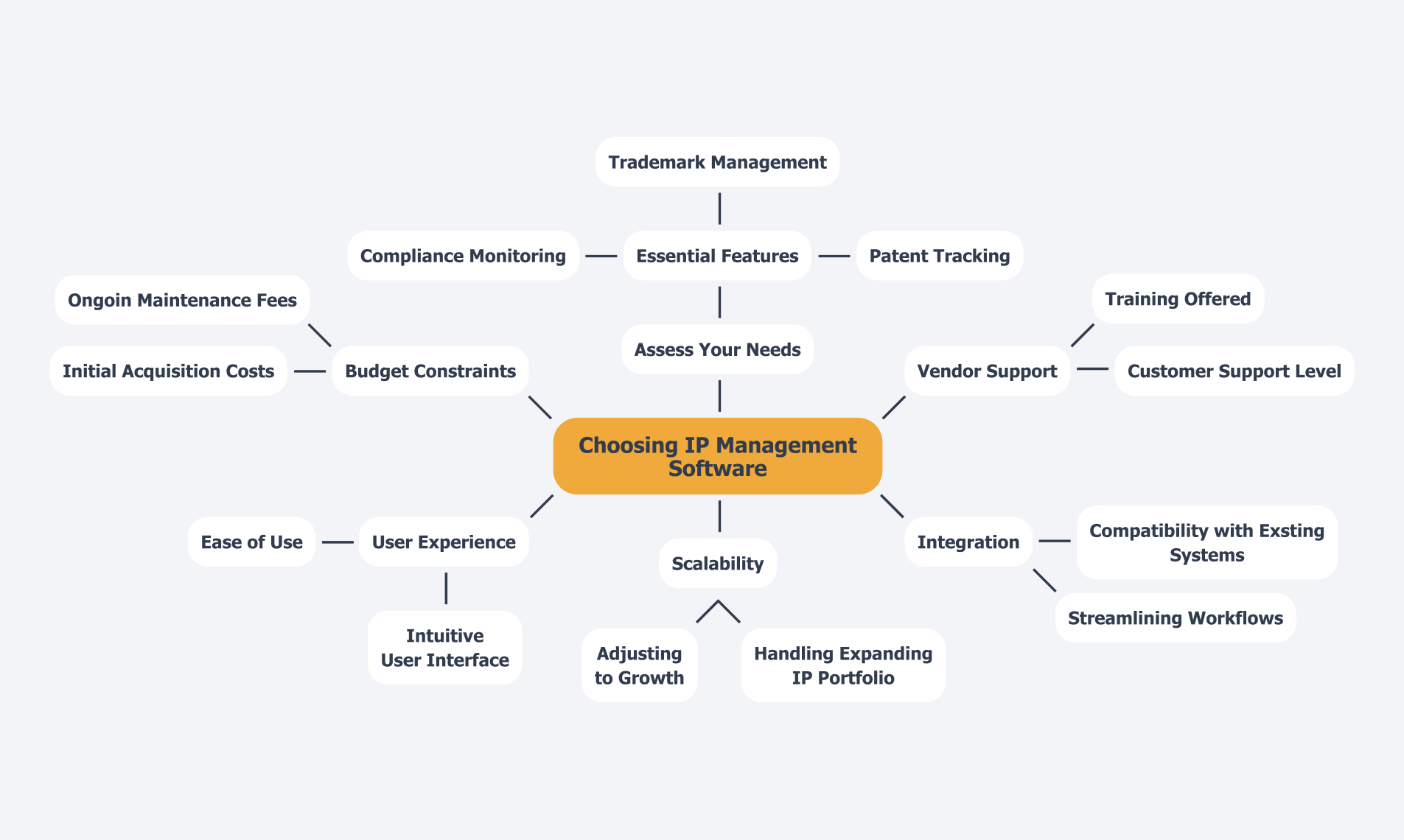
Conclusion
The management of intellectual property is increasingly vital in today’s fast-paced business environment. Organizations must prioritize the protection of their innovations through effective IP management software, such as iPNOTE. These platforms offer a suite of features that streamline processes, enhance compliance, and provide valuable insights, ultimately empowering corporate IP managers to make informed decisions.
Key elements such as automated tracking, centralized databases, and analytics capabilities significantly improve the efficiency and effectiveness of IP management. The integration of AI into these systems is transforming how businesses handle their IP portfolios, allowing for better risk management and strategic alignment with organizational goals. By understanding both the advantages and potential challenges of various software solutions, businesses can make educated choices that align with their specific needs and budget constraints.
In conclusion, the landscape of intellectual property management is evolving, and organizations must adapt to stay competitive. The right IP management software not only safeguards valuable assets but also enhances operational efficiency and informed decision-making. As the demand for sophisticated solutions grows, it is imperative for corporate IP managers to remain proactive in exploring the latest technologies and features available in the market, ensuring their organizations can navigate the complexities of intellectual property with agility and precision.
Elevate Your IP Management with iPNOTE! Start now to streamline your processes and protect your innovations effortlessly.
Frequently Asked Questions
What is the purpose of intellectual property (IP) management software?
IP management software helps organizations safeguard their intangible assets, such as patents, trademarks, copyrights, and trade secrets. It streamlines the tracking, registration, and enforcement of IP rights to protect innovations effectively.
How is AI impacting intellectual property management software?
AI is transforming IP management software by automating routine tasks, providing valuable analytics and insights, improving workflows, reducing operational expenses, and ensuring compliance with evolving IP regulations.
What are some key definitions related to IP management software?
- “User” refers to the individual or organization utilizing the service.
- “Account” is the collection of settings and information associated with a User.
- “Task” denotes a service request made by a Client to potential Consultants.
- “Consultant” refers to professionals providing IP-related services.
What features does iPNOTE’s platform offer for IP management?
iPNOTE’s platform allows users to automate task creation, set reminders, access their IP portfolio, coordinate tasks, receive fixed-price offers from providers, and track progress. Payments can also be made in various currencies through the chat interface.
Why is the adoption of cloud technologies significant for IP management software?
The adoption of cloud technologies enables the creation of cloud-based IP control systems, which is particularly crucial in the IT and Telecom industries that dominate the market share for IP software solutions.
What are the benefits of AI-powered IP control solutions?
AI-powered IP control solutions enhance efficiency, improve decision-making capabilities, and foster collaboration between legal professionals and patent attorneys, providing vital support in navigating the complexities of intellectual property.
How can IP oversight tools be customized?
IP oversight tools allow for the customization of reports and agreements to meet client needs, demonstrating their flexibility to accommodate diverse organizational requirements.
What measures does iPNOTE take to ensure data privacy and security?
iPNOTE is dedicated to data privacy and security, ensuring that all user information is safeguarded in accordance with relevant regulations.
What should corporate IP administrators consider regarding AI-driven approaches?
Corporate IP administrators should understand both the advantages and potential drawbacks of AI-driven approaches to leverage technology effectively in their IP management practices.




